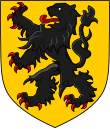| House of Flanders | |
|---|---|
 Arms of the County of Flanders | |
| Country | |
| Founded | 863 |
| Founder | Baldwin Iron Arm |
| Final ruler | Jerusalem: Baldwin I Boulogne: Matilda I Flanders: Margaret II |
| Titles | |
| Estate(s) | Flanders, Hainaut, Constantinople, Boulogne |
| Dissolution | 10 February 1280 |
| Cadet branches |
|
The House of Flanders, also called the Baldwins (Latin: Balduini, French: Baudouinides), was a medieval ruling family of Frankish origin that was founded by Baldwin Iron Arm, son-in-law of Charles the Bald. The House of Flanders was the first dynasty to transform a county function of the Carolingian Empire into a hereditary fiefdom, the County of Flanders, falling under West Francia and the subsequent Kingdom of France, following the empire's partition acted by the Treaty of Verdun in 843.[1]
From 1051, the House of Flanders also reigned over the County of Hainaut in the Holy Roman Empire, with Baldwin I of Hainaut. In 1119, on the death of Baldwin VII, the family had a series of setbacks, but in 1191, the family recovered the title of Count of Flanders with Baldwin VIII (Baldwin V of Hainaut). The dynasty also established the Latin Empire of Constantinople during the Fourth Crusade, and briefly ruled the County of Namur (1188–1212). The House of Flanders became extinct in 1280 with the death of Margaret II.
A separate cadet branch, the House of Boulogne, emerged in the 11th century and ruled over the County of Boulogne.[2] Members of this house joined the First Crusade, established the Kingdom of Jerusalem, and produced its first kings.
- ^ Le Glay, Edward (1814-1894) Auteur du texte (1843). Histoire des comtes de Flandre jusqu'à l'avènement de la maison de Bourgogne. 2 / par Edward Le Glay,...
{{cite book}}: CS1 maint: numeric names: authors list (link) - ^ Heather J. Tanner, The Expansion of the Power and Influence of the Counts of Boulogne under Eustace II', Anglo-Norman Studies XIV: Proceedings of the Battle Conference 1991, Ed. Marjorie Chibnall (The Boydell Press, Woodbridge, UK, 1992), p. 251